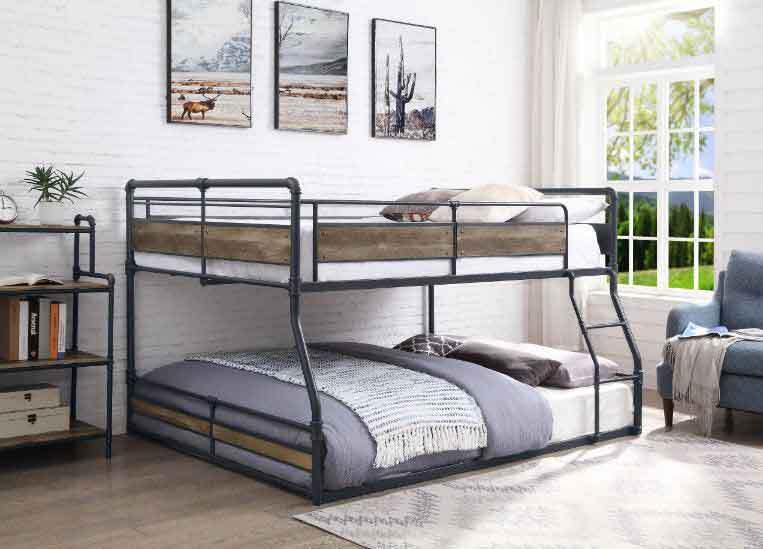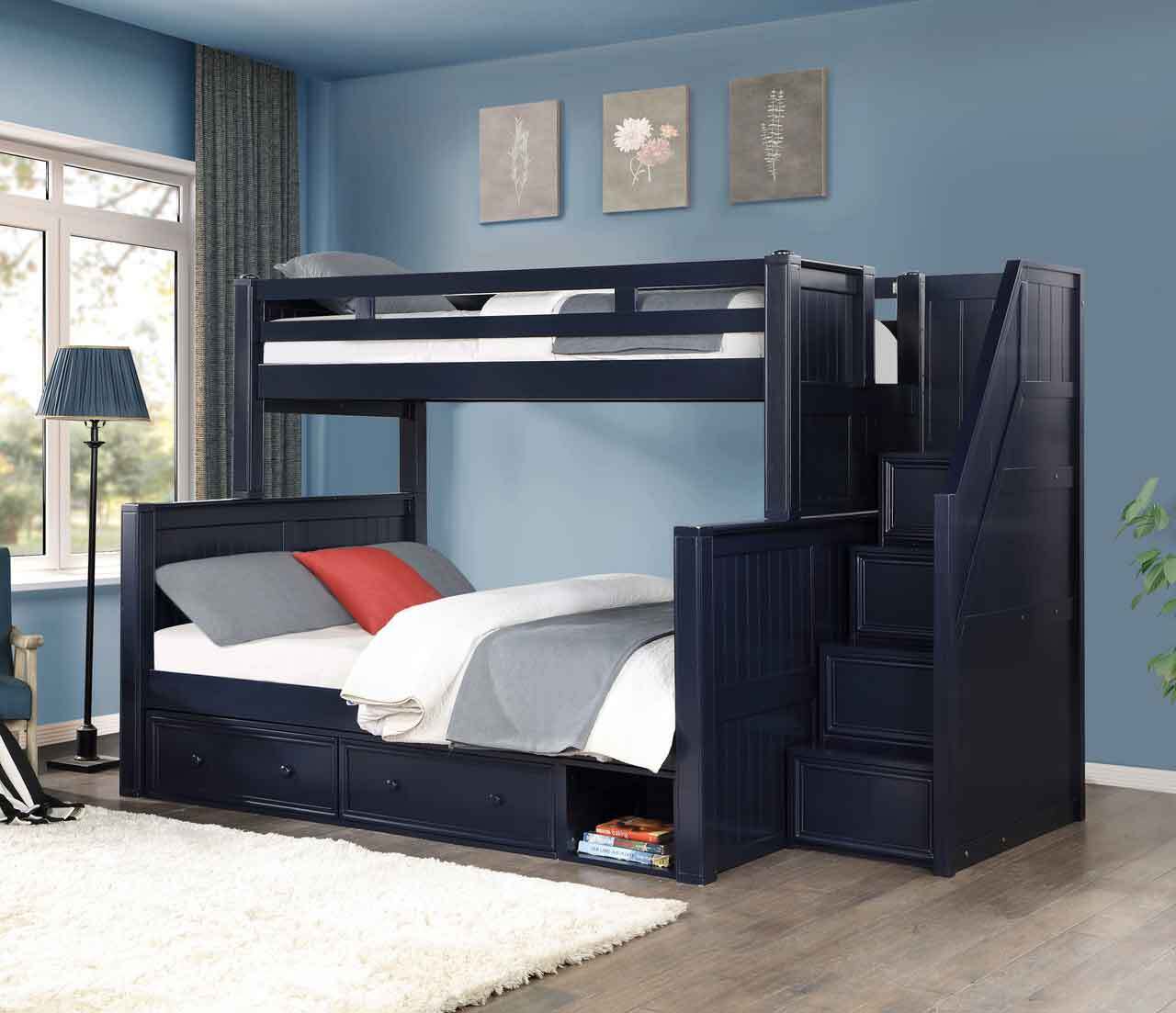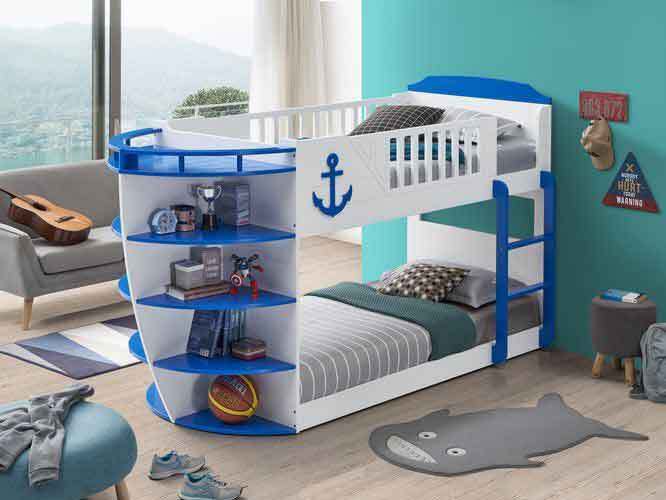How to Choose the Right Bunk Bed
Bunk beds have become a popular solution for maximizing space in modern homes, vacation rentals, and shared living environments. The variety of bunk bed styles has expanded significantly, with options including sturdy metal frames, classic wooden designs, and configurations featuring storage, workspaces, or extra sleeping areas.
With so many factors to consider, how do you decide which bunk bed is the best fit? Understanding key considerations like safety, durability, and design will help you make an informed choice.

What Is the Bunk Bed Rule?
Bunk beds offer a practical sleeping solution, but safety must always come first. To reduce the risk of falls, entrapment, or structural failures, the Consumer Product Safety Commission (CPSC) and the American Society for Testing and Materials (ASTM) have established strict safety regulations for both children's and adult bunk beds.
Understanding these regulations is essential when choosing a bunk bed for your home. A compliant bunk bed provides not only a secure sleeping environment but also peace of mind, knowing it has been tested for durability and safety. By verifying certifications and structural features, you can ensure your bunk bed meets federal safety standards and minimizes potential risks.
How Do I Know if My Bunk Bed Is Safe?
Here’s what to check before making a purchase:
- Certified Compliance – Look for a Children’s Product Certificate (CPC) for kids’ bunk beds or a General Certificate of Conformity (GCC) for adult bunk beds. These certifications confirm the bed has passed safety tests at a CPSC-accepted third-party laboratory.
- Guardrails and Ladder Security – Upper bunks must have two guardrails that are at least 5 inches above the mattress and securely fastened with safety fasteners. The gap between a guardrail and the bed’s end must not exceed 0.22 inches to prevent entrapment. Ladders or stairs should be firmly attached and slip-resistant for safe access.
- Structural Integrity – The bed should have a solid wood or heavy-duty metal frame with reinforced joints. Avoid models with sharp edges, weak support slats, or lightweight materials that could bend or warp over time.
- Entrapment Prevention – Openings in the bed frame should be small enough to prevent a child’s head from getting stuck. No openings should allow a 9-inch sphere to pass through freely, and all gaps must pass the wedge block test, ensuring they do not pose a strangulation hazard.
- Weight Capacity – The bunk bed must support the intended users. Kids' bunk beds typically hold 150–250 lbs. per bunk, while adult models should be rated for at least 400–500 lbs. per bunk.
Regular maintenance is just as important as initial safety. Inspect for loose screws, worn-out slats, or chipped finishes that could compromise stability. Re-tighten hardware as needed and check for any damage that might impact safety.
How Much Room Should You Have Above a Bunk Bed?
Proper ceiling clearance is essential for both comfort and safety. The CPSC recommends at least 30 inches of space between the top bunk mattress and the ceiling. This ensures:
- Safe Sitting and Movement – The user can sit upright without bumping their head. This is especially important for teens or adults who may need more headroom.
- Unobstructed Airflow – Ensuring proper ventilation can improve sleep quality and prevent overheating.
- Safe Distance from Light Fixtures and Fans – Ceiling fans and overhead lights should be at least several feet away from the top bunk to avoid accidental contact.
Before purchasing a bunk bed, measure your ceiling height and compare it with the combined height of the bunk bed frame and mattress to determine available headspace. If ceilings are lower than 8 feet, consider a low-profile bunk bed for added clearance.
How to Choose the Right Bunk Bed for Adults?
Bunk beds for adults require stronger materials and wider configurations to accommodate different sleeping arrangements. Whether you're furnishing a guest room, shared living space, or a personal bedroom, selecting the right size and structure plays a crucial role in comfort and convenience.

Bed Configurations and Sizes
The right bunk bed size depends on who will be using it and how much space is available. Each configuration offers unique benefits, from compact solutions for solo sleepers to spacious options for couples or multiple occupants.
- Full-Size Bunk Beds – If you want extra room to stretch out without taking up too much floor space, a full bunk bed is a good fit. It’s ideal for single adult sleepers who want more comfort or for siblings and roommates who share a bunk but don’t need a queen-size frame.
- XL Bunk Beds – With extended length and increased height clearance, XL bunk beds accommodate taller adults who need additional legroom and more space between bunks. This ensures a more comfortable sleeping and sitting experience, especially for those who don’t want to feel confined in a standard-size bunk.
- Queen Bunk Beds – Designed for maximum sleeping space, queen bunk beds are best for couples, guest rooms, and situations where two people will share a bunk. If you prefer a spacious sleep area but want to maintain vertical efficiency, a queen-size model is the best option.
- Loft Beds – A practical alternative to traditional bunk beds, loft beds offer an elevated sleeping area with open space below for a desk, seating, or storage. This setup is great for small apartments, home offices, or multipurpose rooms where you need to make the most of your available space.
Choosing the right bunk bed configuration depends on your comfort preferences, sleeping habits, and room layout. Additionally, selecting the right access method is essential.
Traditional ladders are compact and efficient, but staircases provide better stability and ease of movement, especially for those who prefer a gradual, secure climb. Some staircases also double as built-in storage, making them a great choice if you need extra space for personal items.
How to Choose the Right Bunk Bed for Kids?
Choosing the right bunk bed for your child goes beyond just picking a style—it’s about finding a bed that suits their daily routines, interests, and long-term needs. Whether your priority is a practical layout, long-term flexibility, or a unique design that makes bedtime more exciting, the right bunk bed can enhance both comfort and usability.
- Safety Features - If your child is particularly active or prone to climbing, a bunk bed with sturdy, non-slip steps is a safer choice than a vertical ladder. For example, the Saturn Twin Bunk Bed includes a built-in ladder and guardrails on all sides for added security, supporting a durable solid wood frame that remains stable over time.
- Convertible or Modular Designs - Some bunk beds can be separated into two individual beds, allowing you to adjust the setup as your child grows or if sleeping arrangements change. This flexibility is especially useful if you anticipate moving the bed into separate rooms in the future. If long-term use is a priority, look for models with a reinforced frame and strong slat support, ensuring both bunks remain sturdy even after repeated disassembly and reassembly.
- Fun and Themed Designs - For younger children or those with a creative imagination, a themed bunk bed can make their sleeping area feel more like their own space. Designs with decorative panels, unique headboards, or fun structural elements can turn a regular bedroom into an engaging environment.
The Freight Container Theme Twin Bunk Bed is an example of a bed that blends function with creativity, featuring cargo container-inspired panels and a bold blue finish. It supports 20 slats per bunk for durability and includes a sturdy vertical ladder with safety rails on both sides.
Choosing a bunk bed that fits your child’s personality, daily routine, and long-term needs ensures a practical and enjoyable sleeping arrangement. Whether you prioritize long-term adaptability or a themed design that makes bedtime more exciting, there’s a bunk bed that meets your requirements while maintaining structural integrity and safety.
What Is the Safest Age for Bunk Beds?
According to the CPSC’s safety guidelines, children under six should not use the top bunk of a bunk bed. Younger children have a higher risk of falls due to their developing motor skills and limited awareness of height-related dangers. Studies have shown that most bunk bed-related injuries among young kids result from falls while climbing up or down the ladder or rolling off the bed while asleep.
Their reflexes and ability to break a fall are not as developed as older children, increasing the likelihood of injury. To prevent accidents, it’s best for younger children to sleep on the bottom bunk while ensuring the top bunk has properly installed guardrails and a slip-resistant ladder for older kids.

Are Wood or Metal Bunk Beds Better?
Wood and metal bunk beds each offer distinct advantages, and the best choice depends on how you plan to use the bed, the level of maintenance you're comfortable with, and the overall look you want for your space.
Wooden Bunk Beds
Wooden bunk beds are built for strength, noise reduction, and long-term use. Hardwoods like oak, maple, and birch provide exceptional structural integrity, making them ideal for family homes, guest rooms, and permanent sleeping arrangements. Because wood absorbs movement, these beds reduce creaking and shifting, creating a quieter sleep experience—especially important for light sleepers.
While wood is naturally durable, periodic refinishing may be needed to maintain its condition, particularly in humid environments where expansion and contraction can occur. Due to their heavier weight, wooden bunk beds are best suited for rooms where furniture placement remains consistent rather than spaces requiring frequent rearrangement.
- Best for traditional, farmhouse, and rustic interiors – The natural grain and rich finishes of wooden bunk beds complement cozy, classic decor. Choose a walnut or cherry stain for a refined, elegant look or a white or gray finish for a softer, contemporary feel.
- Sturdy and long-lasting – High-quality hardwood frames can withstand years of daily use without warping or bending.
- Customizable and finishable – Wood allows for sanding, staining, or painting, making it easy to refresh the bed’s look over time.
- Quieter than metal – Wood absorbs vibrations, preventing squeaks and rattles caused by movement.
Wooden bunk beds are a solid choice for those who want a dependable, noise-free sleeping solution. If flexibility is important, consider convertible wooden bunk beds that separate into two individual beds, offering a long-term option as sleeping needs change.
Metal Bunk Beds
Metal bunk beds offer lightweight durability, affordability, and a modern aesthetic. Constructed from steel or aluminum, they provide strong weight support without the bulk of solid wood. Unlike wood, metal is resistant to temperature and humidity changes, preventing warping or expansion.
However, metal frames can produce noise over time if bolts loosen, so regular hardware checks are necessary to maintain stability. While metal bunk beds don’t require refinishing, paint coatings can chip, especially with frequent movement or active use.
- Best for industrial, minimalist, and contemporary spaces – Metal bunk beds pair well with urban lofts, modern apartments, and student dorms. A black or gunmetal frame enhances industrial-style decor, while white or silver finishes create a sleek, minimalist aesthetic. For a bold touch, opt for bright-colored frames in kids’ or creative spaces.
- Lightweight and easy to move – Metal frames are easier to transport and reassemble, making them ideal for renters, dorm rooms, or flexible living spaces.
- Resistant to environmental changes – Unlike wood, metal does not expand or contract due to humidity, making it a good choice for varied climates.
- Durable powder-coated finishes – High-quality metal beds resist chipping and rust better than painted finishes, maintaining their appearance over time.
Metal bunk beds are a practical option for those seeking affordability and portability. To reduce potential noise, tighten bolts regularly and use rubber washers to prevent metal-on-metal friction.
Whether you need a compact loft bed, a heavy-duty adult model, or a fun, kid-friendly design, making an informed decision ensures long-term satisfaction. Just Bunk Beds offers a range of premium bunk beds built for comfort and reliability—explore our options today or contact us for expert recommendations.
